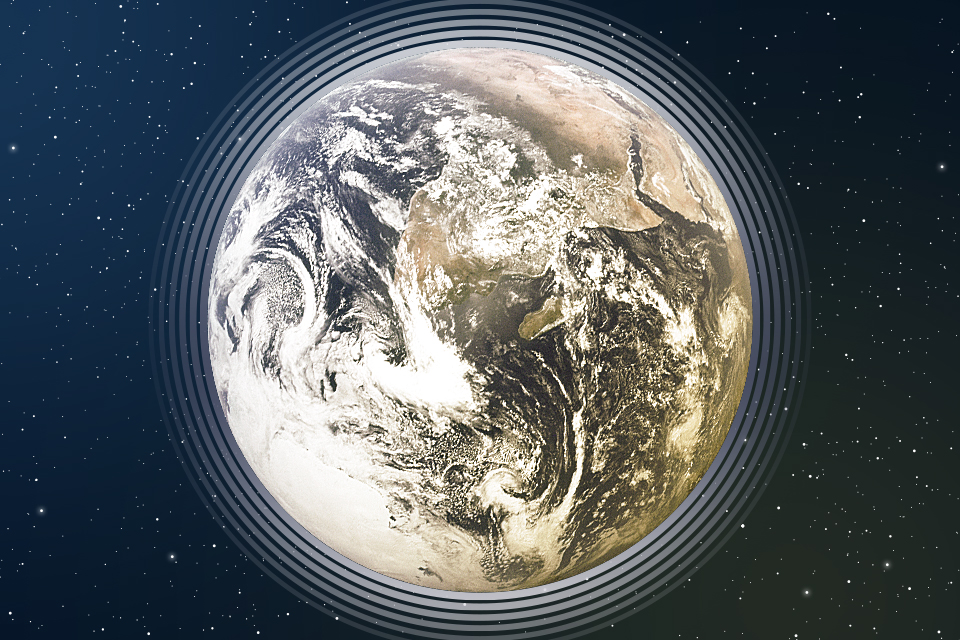On April 22, Earth Day is celebrated around the world. Contemplating its vast expanses, it is very easy to forget that it is one of the planets of the Solar System. And there is also something to tell about it as a celestial body.

1. What is the shape of the Earth?
A lot of people still, either jokingly or sincerely, claim that the Earth is flat. However, even the answer that it is a sphere is not really accurate enough. The figure of the Earth is slightly flattened at the poles. This shape is called an ellipsoid of rotation.
The difference between the polar and equatorial radii of the Earth is 21 km. Compared to the 6371 km of the average radius, this is quite a bit, but still, even in approximate calculations, our planet is not considered a sphere.
When it is necessary to calculate the movement of a spacecraft in near-Earth orbit, it is believed that the Earth has a very unique geometric shape — a geoid. It reflects all the major depressions and bends present on the earth’s surface.
2. Where does the Earth’s atmosphere end?
Like most other planets, the Earth has a gaseous envelope called the atmosphere. Its composition mainly includes nitrogen, oxygen, argon, water vapor and carbon dioxide. But its thickness depends on where to draw its outer boundary.
The Earth’s atmosphere is conventionally divided into several layers. The troposphere lies closest to the surface, extending upwards for 6-20 km. This is the air we are used to and the area where rain clouds form. Above, at an altitude of up to 50 km, there is the stratosphere, which is the same mixture of gases, but the pressure here is already too low for us to breathe it.
Even higher, at altitudes between 50 and 85 km, is the mesosphere. The density of gases in it no longer allows for aerodynamic flight, although it is still enough for space rocks to flare up like meteors due to friction when entering it.
Finally, the thermosphere and exosphere are even higher. Only individual gas molecules are found here, so it is still a part of the Earth’s atmosphere that does not have a clear outer boundary.
3. What is the name of the highest mountain on Earth?
From the school geography course, everyone knows that the highest mountain on Earth is Mount Everest. It is located in the Himalayas and has an altitude of 8848 m. However, it received this name only in the twentieth century. Its traditional name sounds like “Jomolungma”, or “Chomolungma” — depending on which transcription to use.
However, this is true only if you count the height of the mountain from sea level. If, instead, we consider the total distance from the base to the top, then the highest peak of the planet will be the volcano Mauna Kea in the Hawaiian Islands. Its total height is 10305 m, but about 6 thousand of them are hidden under water.
In addition, there is also a third way to determine the height of a mountain — as the distance from the center of the Earth to its top. In this case, you have to take into account the shape of the Earth, which is slightly inflated at the equator. Then the highest peak of our planet will be the Chimborazo volcano in Ecuador. Its peak is 6384.4 km away from the center of the Earth, while Mount Everest is only 6382.3 km away.
4. What are the most chemical elements on Earth?
The Earth consists of approximately the same chemical elements as the rest of the terrestrial planets of the Solar System. Most of all, it contains iron — 32.1% of the total weight. It is followed by oxygen (30.1%), silicon (15.1%), magnesium (13.9%), sulfur (2.9%), nickel (1.8%), calcium (1.5%) and aluminum (1.4%). The remaining elements account for only 1.2%.
At the same time, the vast majority of iron and nickel, as well as a lot of sulfur, are found in the heaviest part of our planet — its core. Therefore, the composition of the earth’s crust, that is, those rocks with which we are in direct contact, is noticeably different.
Oxygen accounts for the largest share of the Earth’s crust mass, of which 46.1% is contained in it. It is followed by silicon (28.2%), aluminum (8.23%), iron (5.63%), calcium (4.15%), sodium (2.4%), potassium and magnesium — 2.3% each. One percent is hydrogen, the most abundant element in the universe.
5. Is the Earth a binary planet?
If you look at the Earth as a celestial body, then its most amazing feature will be the presence of not so much life as the Moon. No other major planet has such a large moon in comparison with it. Their mass ratio is 81/1. At first glance, this is not much, but it still shifts the center of rotation of the system by 1/82 from the center of the Earth, which corresponds to 4383 km.
Since this value is less than the radius of our planet, the total center of mass (barycenter of the system) still lies below the earth’s surface. Therefore, the Earth and the Moon cannot be considered a binary planet, although they are quite close to this state.
Follow us on Twitter to get the most interesting space news in time
https://twitter.com/ust_magazine


